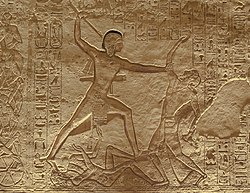Battle of Kadesh

The Battle of Kadesh took place in the 13th century BC between the Egyptian Empire, led by Pharaoh Ramesses II, and the Hittite Empire, under King Muwatalli II. The armies clashed at the Orontes River, near the archaeological site of Kadesh, located along the Lebanon-Syria border. The battle, dated to May 1274 BC according to Egyptian chronology, is notable for being the earliest recorded battle with detailed tactics and formations. It is also considered the largest chariot battle ever fought, involving approximately 5,000 to 6,000 chariots. Despite Ramesses' initial setbacks, including being ambushed and surrounded, he led a countercharge that managed to break through the Hittite ranks, resulting in a stalemate.
Background tensions stemmed from earlier Egyptian campaigns to reclaim control over their borders following the expulsion of the Hyksos. Thutmose I and his successors pushed Egyptian influence northward to the Orontes River, but later rulers, such as Amenhotep III, saw a decline in Egyptian control. The Amarna letters document Egypt's waning influence until the late Eighteenth Dynasty. The Nineteenth Dynasty, under Seti I, sought to restore Egypt's dominance. Seti I's campaigns, including the capture of Kadesh, were continued by his son, Ramesses II. By the fifth year of Ramesses' reign, tensions with the Hittites, who sought to recover Amurru, led to the decisive clash at Kadesh.
The battle saw Ramesses leading four divisions: Amun, Re, Set, and the newly formed Ptah division, along with a contingent of Ne'arin troops. Muwatalli II assembled a coalition of allies, significantly outnumbering the Egyptians. Misled by Hittite spies, Ramesses was caught off guard, leading to a disorganized engagement. Despite the initial chaos and the effective Hittite chariot attack, Ramesses' personal bravery and strategic counterattacks, along with the timely arrival of the Ne'arin and Ptah divisions, turned the tide. Although neither side achieved a decisive victory, the battle's outcome forced a strategic withdrawal by Ramesses. The subsequent campaigns by both empires continued the conflict until a peace treaty in 1258 BC finally ended hostilities, marking the battle as a crucial turning point in the protracted Egyptian-Hittite rivalry.
